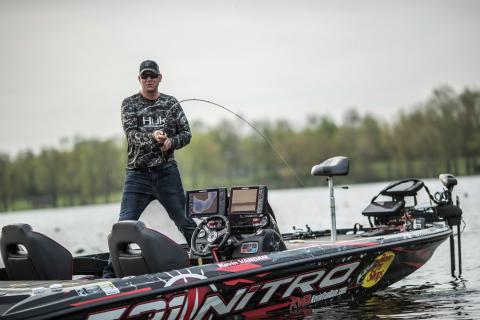Gerald Almy | Originally published in GameKeepers: Farming for Wildlife Magazine. To subscribe, click here.

The first time I planted a warm season annual I chose lablab. Our local deer in Virginia had never seen or tasted this plant before. And that’s probably the reason they left it alone until it was well-established. Soon, I had lush plots two feet high of the big-leaved lablab.
That was great. But eventually I began to wonder: why weren’t the deer eating it? Was this plant all “hype” as a whitetail food? Then a few brave does and finally some bucks started munching on the new offering. Once they got used to it, they obviously decided it was pretty good. Bucks, does and fawns gorged on it all the rest of the summer until frost ended the party.
The next spring, my lucky streak ended. This time the young plants weren’t four inches tall before deer began browsing…and browsing and browsing. The plant was no longer new to them and there was no learning-curve to deal with. They knew they liked it. Within days the plot was all but obliterated! The lablab struggled to come back, but never did produce much more forage that year.
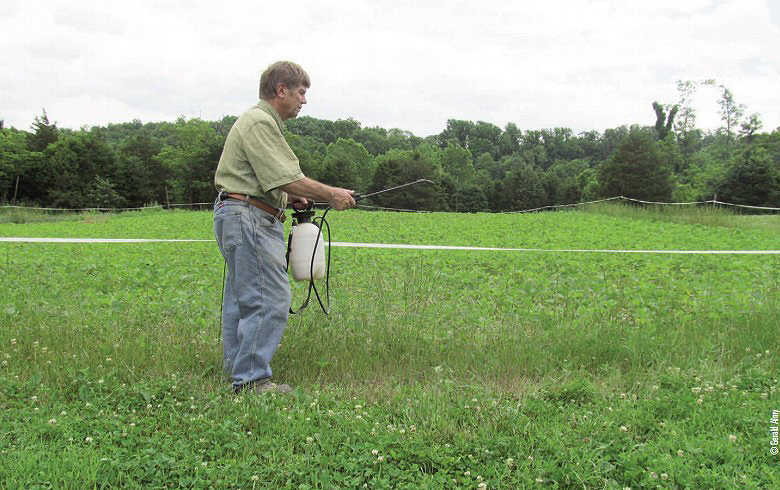
I had been charmed the first year into thinking growing big-leaved, warm-season annuals would be a cinch. Boy, was I ever fooled. Once the deer developed a taste for the “new” lablab food source, they targeted it the following year immediately and ransacked the vulnerable seedlings.
I switched to forage soybeans, thinking they might work better. But this time there wasn’t even a grace period where the deer ignored the crop. They knew soybeans well from surrounding farmers’ fields and fed voraciously on the young plants. These were Eagle forage soybeans, designed to withstand feeding pressure, so some plants survived. But, they didn’t develop to the potential they could have if they’d somehow been protected during their early, vulnerable growth stages.
That was my rude introduction to the challenge of protecting young plants in food plots until they’re at a stage where browsing pressure from deer won’t harm them. Early feeding on young plants can drastically reduce a plot’s forage production and even kill some cultivars such as cowpeas and lablab.
By protecting plots when they’re young you can “shepherd” them through their early growth stages until the plants are large enough to withstand overbrowsing and still thrive. The more leaves the plants develop, the more they’re able to absorb heavy browsing without fatal results.
Fortunately, the food plotter has a wide variety of tactics he or she can turn to for protecting young plants. But before getting into those, it’s worth pointing out two preliminary steps you can take to reduce food plot damage. One is to prepare a good planting site, balance the pH, and add needed fertilizer. This will result in stronger, faster-growing plants that can better withstand heavy browsing. The second thing you can do is to try to keep the local deer herd balanced with the habitat by harvesting enough does. Now let’s look at the protection tactics. I’ve come to the realization over 25 years of growing food plots that no single method is best for all land managers. Often it’s wise to employ a combination of strategies to shelter vulnerable young plants. Depending on your situation you may need to use just one, or perhaps four or five of these.
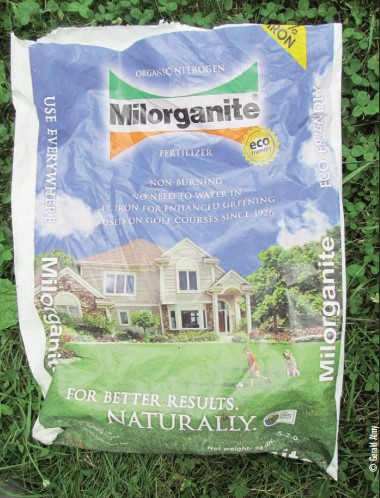
processing sewage sludge. The drawback is your herd
will likely grow accustomed to it and it won’t deter them
as well after time, but it can be effective for protecting
large areas over short time spans.
This setup uses a nylon tape set at nose level of deer that’s saturated in a smell that whitetails dislike (including items such as cayenne, eggs, and garlic). This provides a “wall of scent” that discourages them from entering the plot. Set stakes or fence posts, attach the ribbon at 30 inches height, and then spray with the concentrated repellent mixed with water. You can also pre-spray the poly tape before setting it up or soak the ribbon in a bucket of the solution to saturate it even better. The system uses the smell to deter deer and also, to some extent, the sight of the ribbon fence. This system is inexpensive and usually works reasonably well. I like it because you can use it with any shape or size plot and it’s quick and simple to set up. You can reapply the scent after heavy rains, but it’s designed to last long enough for the forage to become browse-tolerant. If you only have a few small plots, you can even spray some or all of the plants themselves for additional protection. Over time, some deer may overcome their dislike of the smell and either jump over or crouch under the ribbon to get to the plants. If this happens, bolster the spot with an extra strand, however, typically it’s only a few deer. Most animals stay out.
Milorganite Fertilizer
This is a fertilizer made from bio-solids left after processing sewage sludge. It doesn’t smell as bad as you might think, but deer dislike it, especially when it gets wet. It’s a byproduct of the Milwaukee, Wisconsin waste treatment plant, but other similar products may also be available in your area. By spreading a perimeter layer of this fertilizer around the outer edges of your plots, you can discourage the animals from feeding on the plants. Better yet, apply it to the entire crop at a rate of about 240 pounds per acre. You’ll get even more repellent effect that way. Since it’s a 5-2-0 fertilizer with four percent iron, you’re also benefiting the soil and the crop.
A University of Georgia study by Odin Stephens tested Milorganite-treated soybean plots against untreated ones and found far more plants survived with the fertilizer applied. After three days, 54 percent of untreated plants were browsed while only 24 percent of those where Milorganite was applied were browsed. By day 20, the ratio was 59 percent browsed with Milorgante versus 99 percent untreated. At day 30, all the untreated plants were browsed but “only” 80 percent of fertilized plants were. Stephens recommended reapplying after 14 days for the best effect. I’ve found similar or slightly better results from my testing.
I’ve also found that Milorganite works well the first few times you use it, but that some animals soon learn to “hold their noses” and feed in the plot anyway. Even if it only repels the animals for a short period, though, it helps the plants get that much more growth.
Electric Fences
Fences are one of the most highly efficient and respected methods of all for keeping deer out of a food plot, either temporarily or for the long term. A variety of systems are available, many using a solar charger and battery setup. They’re a bit expensive and involved to rig up, but work extremely well. Electric fences are best for setups where you are protecting one or two large plots and want a permanent solution. The only other potential negative is that deer may be reluctant to return to the plot after being shocked several times. Some systems use a single charged fence, while others use a staggered dual perimeter method with a short 18-inch outer fence and another 24-inch high fence three-foot inside that to keep animals out. Both the electric shock and depth perception problems with the two staggered-height fences discourage the deer from entering the plot.
Temporary Fences
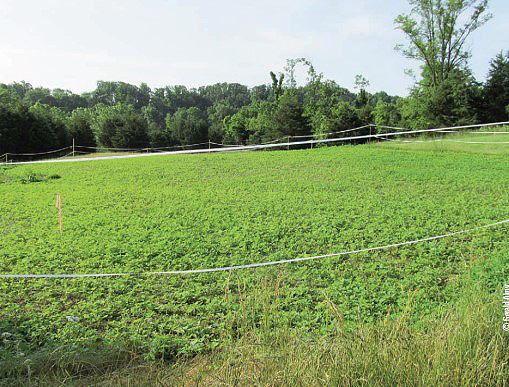
etc.) can act as a visual deterrent.
Leonard Rue, the famous wildlife photographer, has shot pictures of whitetails jumping nine-foot fences. But unless they’re really motivated, deer don’t like to jump a fence even seven feet high. Because of that, putting up a temporary fence is a good way to for the time being keep them out. Plastic mesh fences made specifically for this purpose are available for food plotters, gardeners, and vineyard owners. You can buy seven-foot-high mesh fencing as cheap as $18.48 for 100 feet at Walmart, but those are fragile and can easily break apart. More durable plastic-mesh fencing is a better bet, but it’s more expensive. These systems can be “rolled up” or taken down to allow deer to enter when the crop has grown enough to withstand browsing.
Living on an outdoor writer’s income, I’ve experimented by making my own “poor man’s” temporary fences. I simply set up stakes or eight-foot 2x3s and run poly-tape, fishing line, twine, caution tape, or surveyor’s ribbon around them about 14-18 inches apart. This is a bit of work, but the cost is modest. I then attach widely spaced ribbons for visibility. Deer can squeeze through the twine or tape, but few of them do. To make it more efficient, spray P2 Plot Protector scent on the second strand.
Some hunters also report having success with a non-electric dual-perimeter fence. Erect an outer fence 18-24 inches high using ribbon, wire, or poly-tape and a 2 ½-3-foot high inner fence positioned three feet inside it. This is similar to electric fence setups, but simply uses the problem of depth-perception to discourage entry instead of a shock. The deer aren’t sure they can jump across both fences, but know there’s not room to land between them and jump a second time.
Add a Nurse or Cover Crop
Sometimes the best way to protect a planting is to include another food and cover source that grows taller and helps shield the lower growing plants from deer and divert their feeding efforts. Planting oats or wheat with clover in the late summer or fall is a prime example. Add about 50 pounds per acre to the clover or alfalfa. Blends from BioLogic such as Premium Perennial and Perfect Plot come already mixed with brassicas and cereal grains that provide a nurse or shelter crop to protect the clovers and chicory. Deer feed on the taller, faster growing brassicas and grains while the clover and chicory establish themselves. For warm season annuals, combine corn, sorghum, or sunflowers with cowpeas, lablab, soybeans, or BioLogic’s BioMass All Legume. The taller plants will help shelter the legumes until they can withstand browsing pressure.
Provide alternative plant food sources. This strategy involves luring or enticing deer away from your newly planted, vulnerable seedlings by offering them another abundant high-quality food nearby. A prime example would be having perennial alfalfa, chicory, or clover plots growing strongly near your emerging lablab or soybean plots. You can make these alternate food sources even more appealing with a fresh cutting that stimulates growth of new tender Protecting Your Food Plots continued shoots, a spike of 0-46-0 and 0-0-60 or similar fertilizer, or by watering if conditions have been dry. Maybe not all of the deer will be distracted by this other quality food plot, but it’s one more “arrow in your quiver” to help protect the young plants. And every deer that feeds elsewhere allows your vulnerable emerging seedlings that much more growth. A variation of this would be to fence off most of your warm season annual crop, but leave part of it or a separate plot available for them to feed on.
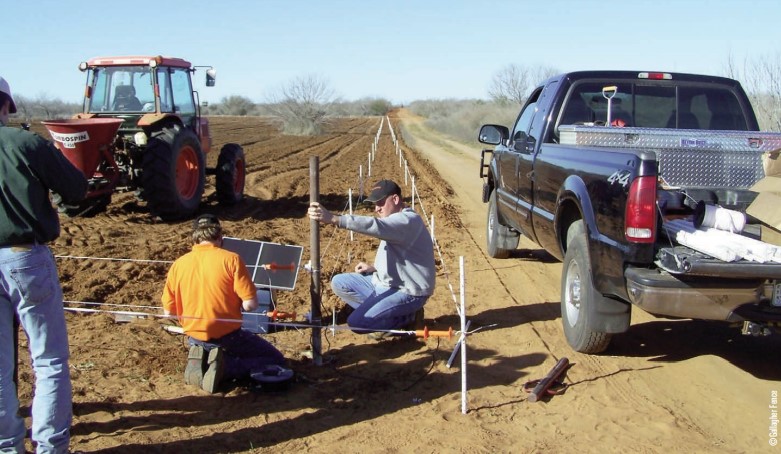
Put out supplemental feed (where legal.) Another way to distract and lure deer away from your plots while they’re young is to dole out a free handout. Offer corn, protein pellets, or whole roasted soybeans to keep their bellies full. To give them time to find and get used to the supplemental feed, start feeding a few weeks before your seedlings will be coming up. Offer it until the plants are large enough to withstand grazing pressure and bounce back. Then slowly taper back on the supplemental feed, unless you decide to keep it a part of your management program. This won’t deter all deer from feeding on the young seedlings. But every mouthful less that they consume allows that many more of the young plants to grow to the viable stage where browsing won’t hurt them. Each of these protection methods can simply be looked at as a single component in a multi-part plan. And some will work better for one gamekeeper than another.
Overwhelm your Herd with Abundant Food
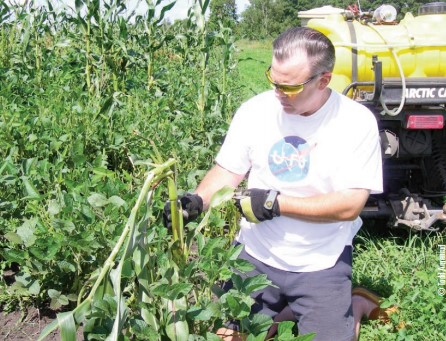
vulnerable plant until it’s able to withstand pressure. However,
sometimes it means both plants get damaged, if not from browse
pressure, oftentimes from trampling.
I saw Bobby Cole mention this in a column a few issues back and it really hit home. I realized that this is the perfect phrase for what I had already settled on as my favorite method of all for protecting young food plots. And it’s probably the best strategy for most wildlife managers, whenever possible. Simply put, plant so much acreage that the deer cannot damage all of the plants, allowing the majority of them to thrive, and as the plants that aren't browsed grow taller with more leaves, deer will shift to those. Often that will allow many of the ones they’ve been feeding on to recoup and start growing again. With soybeans, lablab and cowpeas, the big three summer annuals, this is clearly the single best “protection” method of all. You may have to plow up some older declining perennial plots. You may have to clear some new areas for planting. But whatever it takes, get enough annuals in the ground that deer simply can’t damage a major portion of them.
Besides the fact that it works, one of the reasons I like this approach is that it allows deer access to the high-protein food you’re growing immediately. With many of the other techniques discussed, you’re denying them the food. Sure, it’s only temporarily. But it’s really better if the animals are allowed access to this protein-rich forage as soon as possible. That way the does’ milk will be most nutritious and bucks’ antlers will get a boost during their critical early growing stages in May and June. And by not blocking off access to the plots, you’re also improving the chances that deer will stay on your property and won’t head to the neighbor’s farm. After all, you do want the deer to eat the food you’ve grown. Even if they damage lots of plants, if the plots still produce enough so there’s always ample forage available, they’re serving their purpose. You want the deer to eat the leaves, just not Sometimes planting two crops together can protect the more vulnerable plant until it’s able to withstand pressure. However, sometimes it means both plants get damaged, if not from browse pressure, oftentimes from trampling. Some of my plots look pretty ragged by August from heavy feeding pressure, but as long as they’re still producing plenty of green forage, that doesn’t bother me. I won’t win any beauty contests for prettiest plots, but the deer are getting the protein they need as the plants continue to produce more fresh leaves.
It’s impossible to say what amount of planting will “overwhelm” the deer with food. It will vary with what other forage you have growing, the density of the herd, whether you use supplemental feed or have good perennial plots available, soil fertility, rain and other factors. You’ll soon find out what that “terminal level” is and if you haven’t quite reached it on your first attempt, expand the plot or add additional ones the following year. You won’t regret it when you see more deer using your land that are not only healthier and heavier, but also sport larger racks than neighboring properties. Healthier deer. Bigger deer. Those are goals I think most gamekeepers share. Providing them an all-you-can-eat buffet of high protein forage is the best way I know to reach that goal. But sometimes the other tactics outlined here for protecting young plots may be helpful to assure that your local deer herd has this endless supply of quality food.















